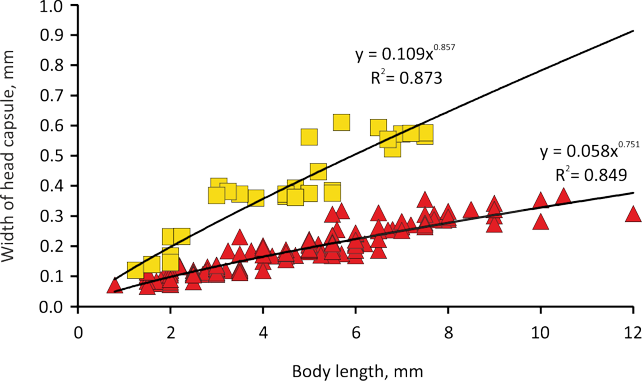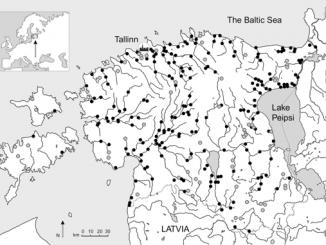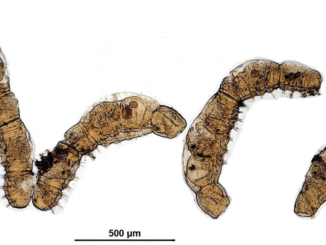
Paper category: Original research paper
Corresponding author: Elena V. Anufriieva (lena_anufriieva@mail.ru)
DOI: 10.2478/ohs-2019-0028
Received: 23/03/2019
Accepted: 17/06/2019
Full text: here
Citation (APA style): Shadrin, N., Belyakov, V., Bazhora, A., et al. (2019). Does salinity affect body proportions and “size/mass” ratios of highly halotolerant Baeotendipes noctivagus larvae (Diptera, Chironomidae)?. Oceanological and Hydrobiological Studies, 48(4), pp. 305-315. Retrieved 10 Dec. 2019, from doi:10.2478/ohs-2019-0028
Abstract
Measuring the linear characteristics of chironomid larvae is easier and faster than measuring their mass. The relationships between them are approximated by parabolic equations. Generalized equations are provided for all chironomid larvae. However, these relations vary in different water bodies. Measurements of 1424 chironomid larvae representing several species were taken in Crimean waters with salinity ranging from 0 to 280 PSU. There was a high correlation between three traits. In the case of Baeotendipes noctivagus and Cricotopus gr. sylvestris, dimorphism was found in the “head capsule length–width” relationship. Salinity affects the head capsule. The exponent “b” varied from 1.43 to 3.06 in the “body length-mass” equation for B. noctivagus, and from 1.943 to 2.592 for C. gr. sylvestris. It is inappropriate to use only one coefficient “b” for all chironomid larvae. In B. noctivagus and Paratanytarsus confuses, the mass of one-size larvae decreased with increasing salinity. Salinity is not the only factor affecting the size and mass of chironomid larvae.
References
Anufriieva, E., Hołyńska, M. & Shadrin, N. (2014). Current invasions of Asian Cyclopid species (Copepoda: Cyclopidae) in Crimea, with taxonomical and zoogeographical remarks on the hypersaline and freshwater fauna. Ann. Zool. 64(1): 109–130.
Anufriieva, E. & Shadrin, N. (2014a). Resting stages of crustaceans in the Crimean hypersaline lakes (Ukraine) and their ecological role. Acta Geol. Sin. 88: 46–49.
Anufriieva, E.V., & Shadrin, N.V. (2014b). Factors determining the average body size of geographically separated Arctodiaptomus salinus (Daday, 1885) populations. Zoological Research 35(2): 132–141.
Anufriieva, E.V. & Shadrin, N.V. (2015). Morphometric variability of Arctodiaptomus salinus (Copepoda) in the Mediterranean-Black Sea region. Zoological Research 36(6): 328–336.
Anufriieva, E.V., Vdodovich, I.V. & Shadrin, N.V. (2018). First data on predation of Eucypris mareotica (Crustacea, Ostracoda) in hypersaline waters. Food Webs 16: e00090.
Armitage, P.D., Pinder, L.C. & Cranston, P. (1995). The Chironomidae: Biology and ecology of non-biting midges. London: Chapman & Hall.
Balushkina, E.V. (1987). The functional significance of chironomid larvae in inland water bodies. Leningrad: Nauka. (In Russian).
Balushkina, E.V., Golubkov, S.M., Golubkov, M.S., Litvinchuk, L.F. & Shadrin, N.V. (2009). Effect of abiotic and biotic factors on the structural and functional organization of the saline lake ecosystems in Crimea. Zh. Obshchei Biol. 70(6): 504–514. (In Russian).
Belmonte, G., Moscatello, S., Batogova, E.A., Pavlovskaya, T., Shadrin, N.V. et al. (2012). Fauna of hypersaline lakes of the Crimea (Ukraine). Thalassia Salentina 34: 11–24.
Belyakov, V.P., Anufriieva, E.V., Bazhora, A.I. & Shadrin, N.V. (2018). Effect of salinity on chironomid larvae (Diptera, Chironomidae) in hypersaline lakes of Crimea. Biology Bulletin 45(10): 1211–1218.
Biswas, J.K., Rana, S., Bhakta, J.N. & Jana, B.B. (2009). Bioturbation potential of chironomid larvae for the sediment-water phosphorus exchange in simulated pond systems of varied nutrient enrichment. Ecol. Eng. 35: 1444–1453.
Cartier, V., Claret, C., Garnier, R. & Franquet, E. (2011). How salinity affects life cycle of a brackish water species, Chironomus salinarius Kieffer (Diptera: Chironomidae). J. Exp. Mar. Biol. Ecol. 405(1): 93–98.
Donald, G.L. & Paterson, C.G. (1977). Effect of preservation on wet weight biomass of chironomid larvae. Hydrobiologia 53(1): 75–80.
Fonseca, A.L. & Rocha, O. (2004). Laboratory cultures of the native species Chironomus xanthus Rempel, 1939 (Diptera-Chironomidae). Acta Limnologica Brasiliensia 16(2): 153–161.
Goldberg, A.D., Allis, C.D. & Bernstein, E. (2007). Epigenetics: a landscape takes shape. Cell 128: 635–638.
Graham, A.A. & Burns, C.W. (1983). Production and ecology of benthic chironomid larvae (Diptera) in Lake Hayes, New Zealand, a warm-monomictic eutrophic lake. Internationale Revue der gesamten Hydrobiologie und Hydrographie 68(3): 351–377.
Hirvenoja, M. (1973). Revision der Gattung Cricotopus van der Wulp und ihrer Verwandten (Diptera, Chironomidae). Ann. Zool. Fenn. 10: 1–363.
Huston, M.A. & DeAngelis, D.L. (1987). Size bimodality in monospecific populations: a critical review of potential mechanisms. Am. Nat. 129: 678–707.
Khlebovich, V.V. & Aladin, N.V. (2010). The salinity factor in animal life. Her. Russ. Acad. Sci. 80: 299–304.
Kokkinn, M.J. (1990). Is the rate of embryonic development a predictor of overall development rate in Tanytarsus barbitarsis Freeman (Diptera: Chironomidae)? Australian Journal of Marine and Freshwater Research 41(5): 575–579.
Kravtsova, L.S. (2007). The relationships between the body mass and its linear sizes in larvae of three Chironomidae species (Diptera) from the lake Baikal littoral. Zoologichesky Zhurnal 86(11): 1398–1401. (In Russian).
Maier, K.J., Kosalwat, P. & Knight, A.W. (1990). Culture of Chironomus decorus (Diptera: Chironomidae) and the effect of temperature on its life history. Environ. Entomol. 19(6): 1681–1688.
Makarchenko, E.A. & Makarchenko, M.A. (1999). Chironomidae. Non-biting midges. In S.J. Tsalolikhin (Ed.), Key to Freshwater Invertebrates of Russia and Adjacent Lands. V. 4. Higher Insects. Diptera (pp. 210–295). St. Petersburg: Zoological Institute RAS. (In Russian).
Menzie, C.A. (1981). Production ecology of Cricotopus sylvestris (Fabricius) (Diptera: Chironomidae) in a shallow estuarine cove. Limnol. Oceanogr. 26(3): 467–481.
Miyasaka, H., Genkai-Kato, M., Miyake, Y., Kishi, D., Katano, I. et al. (2008). Relationships between length and weight of freshwater macroinvertebrates in Japan. Limnology 9(1): 75–80.
Muehlbauer, J.D., Collins, S.F., Doyle, M.W. & Tockner, K. (2014). How wide is a stream? Spatial extent of the potential “stream signature” in terrestrial food webs using meta-analysis. Ecology 95(1): 44–55.
Müller, P.H., Neuman, P. & Storm, R. (1979). Tafeln der Mathematischen Statistik. Leipzig: VEB Fachbuchverlag.
Nolte, U. & Hoffmann, T. (1992). Fast life in cold water: Diamesa incallida (Chironomidae). Ecography 15(1): 25–30.
Pankratova, V. (1970). Larvae and pupae of Mosquitoes of the subfamily Orthocladiinae in the fauna of the USSR (Diptera, Chironomidae = Tendipedidae). Leningrad: Nauka. (In Russian).
Pankratova, V. (1983). Larvae and pupae of Mosquitoes of the subfamily Chironominae in the fauna of the USSR (Diptera, Сhironomidae = Tendipedidae) Leningrad: Nauka. (In Russian).
Rech, K.C., Guereschi, R.M., Torres, K.H. & Nuñer, A.P.D.O. (2014). Subsidies for production of Chironomus calligraphus larvae (Chironomidae, Diptera) in the laboratory. Invertebr. Reprod. Dev. 58(3): 199–206.
Schütz, S.A. & Füreder, L. (2018). Unexpected patterns of chironomid larval size in an extreme environment: a highly glaciated, alpine stream. Hydrobiologia 820(1): 49–63.
Shadrin, N.V. & Anufriieva, E.V. (2013). Climate change impact on the marine lakes and their Crustaceans: The case of marine hypersaline Lake Bakalskoye (Ukraine). Turk. J. Fish. Aquat. Sc. 13: 603–611.
Shadrin, N.V., Anufriieva, E.V., Belyakov, V.P. & Bazhora, A.I. (2017). Chironomidae larvae in hypersaline waters of the Crimea: diversity, distribution, abundance and production. The European Zoological Journal 84(1): 61–72.
Shadrin, N.V., Anufriieva, E.V., Kipriyanova, L.M., Kolesnikova, Е.А., Latushkin, A.A. et al. (2018). The political decision caused the drastic ecosystem shift of the Sivash Bay (the Sea of Azov). Quatern. Int. 475: 4–10.
Shadrin, N.V., Belyakov, V.P., Bazhora, A.I. & Anufriieva, E.V. (2019). The role of salinity as an environmental filtering factor in the determination of the Diptera taxonomic composition in the Crimean waters. Knowl. Manag. Aquat. Ec. 420: 3.
Stoffels, R.J., Karbe, S. & Paterson, R.A. (2003). Length-mass models for some common New Zealand littoral-benthic macroinvertebrates, with a note on within-taxon variability in parameter values among published models. New Zeal. J. Mar. Fresh. Res. 37(2): 449–460.
Swanson, S.M. & Hammer, U.T. (1983). Production of Cricotopus ornatus (Meigen) (Diptera: Chironomidae) in Waldsea Lake, Saskatchewan. Hydrobiologia 105(1): 155–163.
Toderash, I.K. (1984). Functional importance of chironomids in reservoir ecosystems of Moldova. Kishinev (Chisinau): Shtiintsa Publisher. (In Russian).
Waddington, CH. (1940). Organisers & Genes. Cambridge: Cambridge University Press.
Wiederholm, Т. (1983). Chironomidae of the Holarctic Region: Keys and diagnoses. Part 1. Larvae. Entomologica Scandinavica 19: 457.
Williams, W.D. (1998). Salinity as a determinant of the structure of biological communities in the salt lakes. Hydrobiologia 381: 191–201.



Be the first to comment